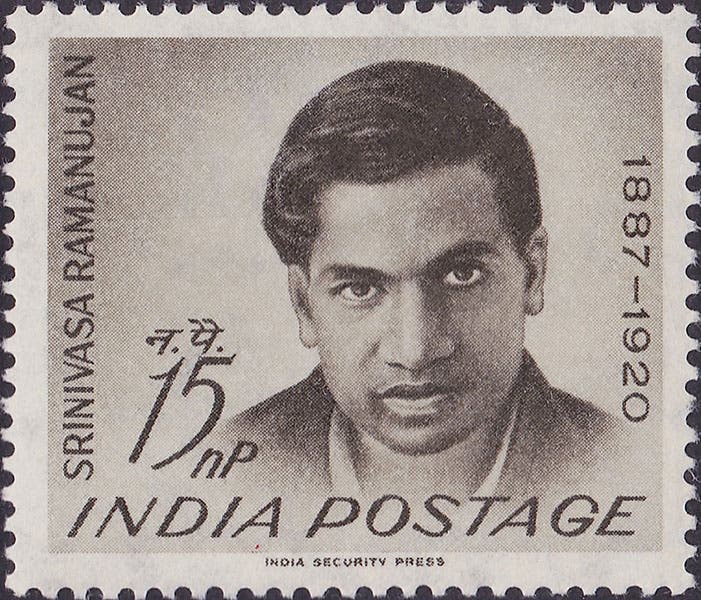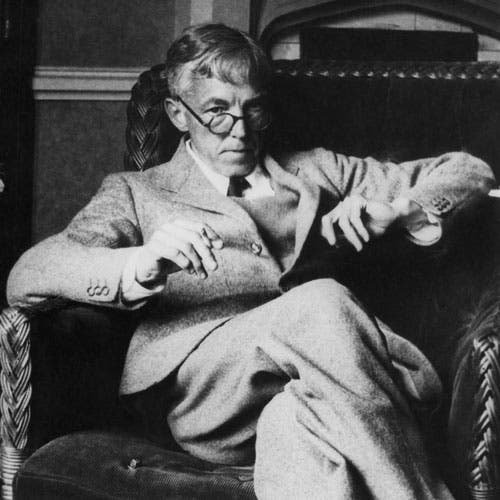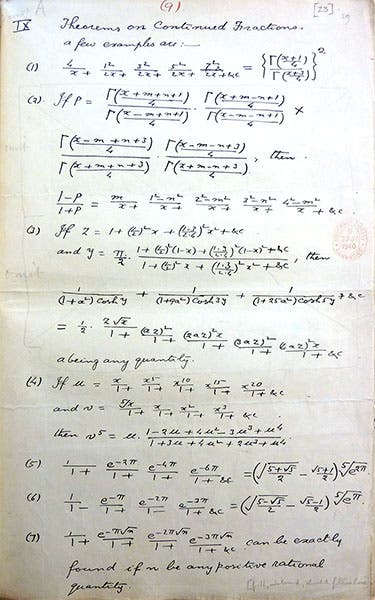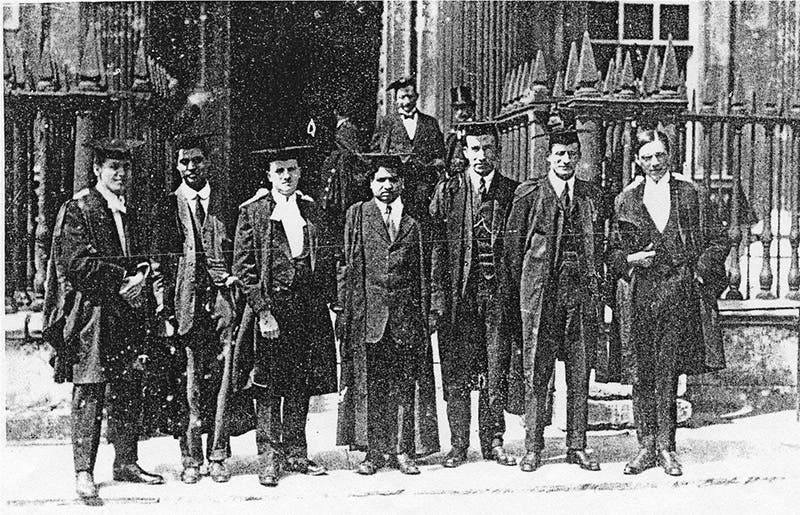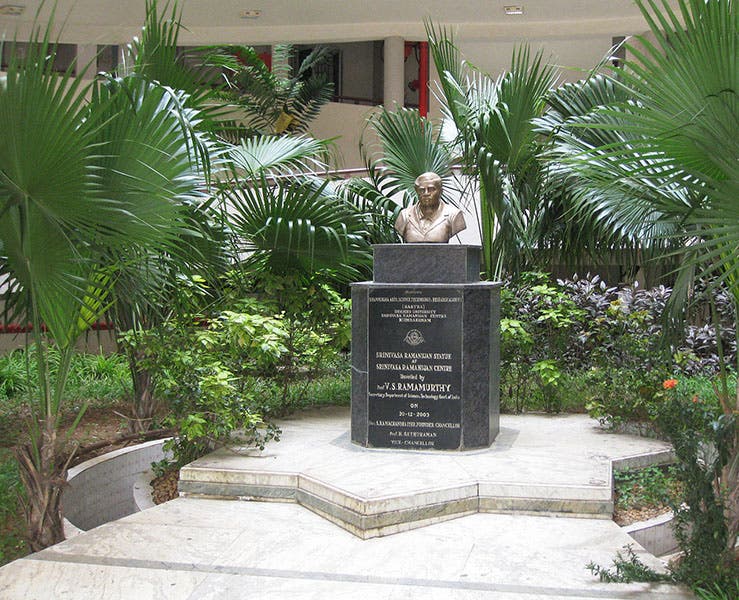Scientist of the Day - Srinivasa Ramanujan
Srinivasa Ramanujan, an Indian mathematician, was born Dec. 22, 1887. Born into a Brahmin family with little means, living south of Madras in southern India, Ramanujan did well enough in school, until he discovered mathematics, which soon captured all his attention. He began to neglect all other subjects except math, to the detriment of his schooling, where he soon lost scholarships, as he failed all exams except mathematical ones. His interest lay in number theory and equations, and such topics as infinite series and prime numbers. Despite his setbacks at school, he received encouragement from teachers and early employers, for he was clearly a mathematical genius.
His mother arranged a marriage for him in 1909; his bride was only 10 years old and did not move in with Ramanujan until later. Some of his patrons found him a job in 1912 as a clerk at the Port of Madras, where he could do the required accounting work quickly and had time for his mathematical pursuits. He had discovered a handbook by G.S. Carr, A Synopsis of Elementary Results in Pure Mathematics: Containing Propositions, Formula, and Methods of Analysis (1886), which contained thousands of equations and formulae, mostly without proofs, intended by school use. Ramanujan worked through the entire 900-page book methodically, and he followed Carr's model in much of his own work, coming up with hundreds of unusual equations, which he seldom bothered to prove (nearly all turned out later to be true). We happen to have a well-used copy of Carr’s Synopsis, the original 1886 edition used by Ramanujan, in our closed stacks, which I feared to leaf through, as the years have not been kind to it (second image).
Since India was at that time under British Rule, Ramanujan began to reach out, in late 1912, to mathematicians in England, hoping to attract notice and perhaps financial support. Most of his inquires received no response, but on Jan. 16, 1913, Ramanujan mailed a letter to a Cambridge mathematician, G.H. Hardy, a competent but hardly brilliant academic at Trinity College. With his letter, Ramanujan sent a packet of at least 11 hand-written sheets containing scores of equations, all without proof. Many described mathematical relationships that were totally unknown to mathematicians. Hardy, to his eternal credit, recognized that the letter-writer was unusually gifted in number theory; he showed the sheets to his collaborator, John E. Littlewood, who was equally impressed. So Hardy wrote back and encouraged Ramanujan in his work. He also asked for proofs of the equations he had received (which Ramanujan never sent – he was not interested in formal proofs at the time). Thus began a correspondence that considerably lifted Ramanujan's spirits and reassured him that he did indeed have unusual talents in number theory.
After some difficulties (the world was soon at war), Hardy arranged for Ramanujan to come to Cambridge to pursue his work in a more favorable environment. Ramanujan boarded ship on Mar. 17, 1914, and one month later he was in Cambridge, where rooms were found for him very near Hardy's. Ramanujan, Hardy, and Littlewood worked together for almost 5 years, and Ramanujan churned out nearly 4000 equations and solutions to problems. Ramanujan was elected to fellowship in the Royal Society of London in 1918, only the second Indian to be so honored, and he was also elected to fellowship at Trinity College, Cambridge. Unfortunately, by that time, Ramanujan was seriously ill. As a Brahmin, he adhered to a strict vegetarian diet, and that was difficult in war-torn England. He spent his last two years in England in sanitaria – he was thought to have tuberculosis – and finally, in 1919, he returned to his home in India, hoping the change of environment (and home cooking) would restore his health. But that was not to be. Ramanujan died on Apr. 26, 1920, at the age of 32, of what is now suspected to have been hepatic amoebiasis, a liver disease that often follows bouts of dysentery.
It is hard for non-mathematicians such as most of us to appreciate Ramanujan’s genius at pure mathematics. Indeed, it was hard for Hardy and Littlewood and the other Cambridge mathematicians to comprehend how Ramanujan’s mind worked. Many of his problem solutions were beyond them. Hardy is supposed to have assigned numerical rankings to the world's great mathematicians, with 100 being the highest. He gave himself a 25, a 30 for Littlewood, thought the great David Hilbert was about 80, and assigned Ramanujan a score of 100.
Not much was made of Ramanujan in the four decades following his death, but he began to be rediscovered in the 1960s, and now everything he every wrote has been published, with exhaustive commentary, including a "lost" notebook found in 1976 with yet more equations. For those who would like to learn more about Ramanujan, I highly recommend: Ramanujan: Letters and Commentary, edited by Bruce C. Berndt and Robert A. Rankin (1995). It begins with a good brief biography, and the commentary to the selected letters is excellent. A biopic film, The Man Who Knew Infinity, was released in 2015, with Dev Patel as Ramanujan and Jeremy Irons as Hardy. I do not watch biopics, as the fictional parts of such films tends to become facts in my memory, and I also do not want to have a mental image of Ramanujan that looks like Dev Patel. But some mathematicians seem to have liked the film, so perhaps some of you would enjoy it.
There is a bust of Ramanujan in Kumbakonam, where he grew up, and where he died; Ramanujan Day is celebrated there, and at other sites in Iindia, every Dec. 22.
William B. Ashworth, Jr., Consultant for the History of Science, Linda Hall Library and Associate Professor emeritus, Department of History, University of Missouri-Kansas City. Comments or corrections are welcome; please direct to ashworthw@umkc.edu.


